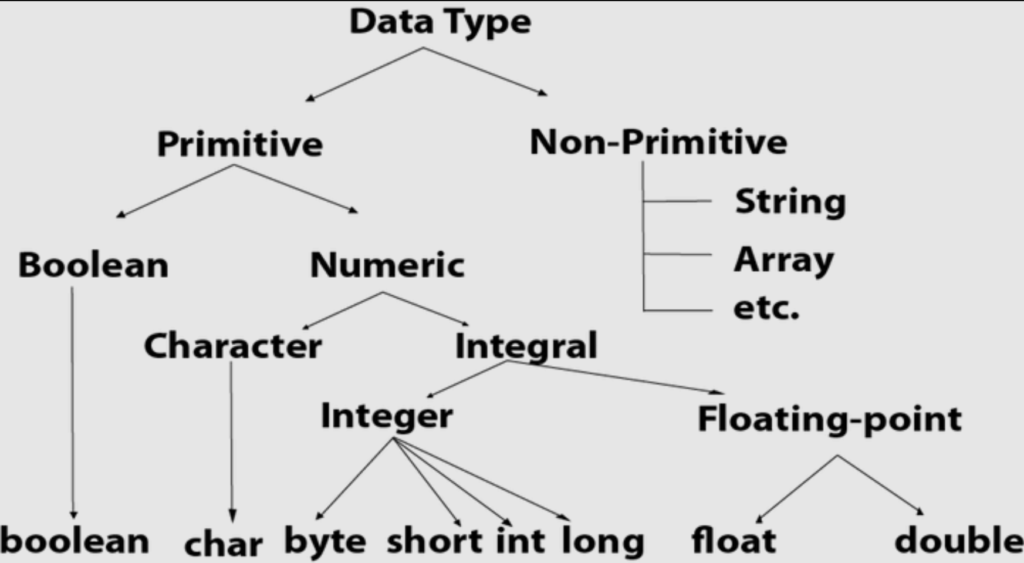Java Data Types specify the different sizes and values that can be stored in the variable.
Java is statically typed and also a strongly typed language. In Java, each type of data (such as integer, character, hexadecimal, packed decimal, and so forth) is predefined as part of the programming language and all constants or variables defined for a given program must be described with one of the data types.
Contents
hide
Types of data types in Java
There are two types of data types in Java:
- Primitive data types: The primitive data types include Boolean, char, byte, short, int, long, float and double.
- Non-primitive data types: The non-primitive data types include Classes, Interfaces, and Arrays.

Java Primitive Data Types
These are the most basic data types available in Java language.
There are 8 types of primitive data types:
- boolean data type
- byte data type
- char data type
- short data type
- int data type
- long data type
- float data type
- double data type
| Data Type | Default Value | Default size |
|---|---|---|
| boolean | false | 1 bit |
| char | ‘\u0000’ | 2 byte |
| byte | 0 | 1 byte |
| short | 0 | 2 byte |
| int | 0 | 4 byte |
| long | 0L | 8 byte |
| float | 0.0f | 4 byte |
| double | 0.0d | 8 byte |
Boolean Data Type
- The Boolean data type is used to store only two possible values: true and false.
- This data type is used for simple flags that track true/false conditions.
- The Boolean data type specifies one bit of information, but its “size” can’t be defined precisely.
Example
Boolean one = false
Byte Data Type
- It is an 8-bit signed two’s complement integer.
- Its value-range lies between -128 to 127 (inclusive).
- Its minimum value is -128 and maximum value is 127.
- Its default value is 0.
- The byte data type is used to save memory in large arrays where the memory savings is most required. It saves space because a byte is 4 times smaller than an integer.
- It can also be used in place of “int” data type.
Example
byte a = 10, byte b = -20 Short Data Type
- The short data type is a 16-bit signed two’s complement integer.
- Its value-range lies between -32,768 to 32,767 (inclusive).
- Its minimum value is -32,768 and maximum value is 32,767.
- Its default value is 0.
- The short data type can also be used to save memory just like byte data type. A short data type is 2 times smaller than an integer.
Example
short s = 10000, short r = -5000
Int Data Type
- The int data type is a 32-bit signed two’s complement integer.
- Its value-range lies between – 2,147,483,648 (-2^31) to 2,147,483,647 (2^31 -1) (inclusive).
- Its minimum value is – 2,147,483,648 and maximum value is 2,147,483,647.
- Its default value is 0.
- The int data type is generally used as a default data type for integral values unless if there is no problem about memory.
Example
int a = 100000, int b = -200000 Long Data Type
- The long data type is a 64-bit two’s complement integer.
- Its value-range lies between -9,223,372,036,854,775,808(-2^63) to 9,223,372,036,854,775,807(2^63 -1)(inclusive).
- Its minimum value is – 9,223,372,036,854,775,808 and maximum value is 9,223,372,036,854,775,807.
- Its default value is 0.
- The long data type is used when you need a range of values more than those provided by int.
Example
long a = 100000L, long b = -200000L
Float Data Type
- The float data type is a single-precision 32-bit IEEE 754 floating point.
- Its value range is unlimited.
- It is recommended to use a float (instead of double) if you need to save memory in large arrays of floating point numbers.
- The float data type should never be used for precise values, such as currency.
- Its default value is 0.0F.
- Stores fractional numbers.
- Sufficient for storing 6 to 7 decimal digits.
Example
float f1 = 234.5f
Double Data Type
- The double data type is a double-precision 64-bit IEEE 754 floating point.
- Its value range is unlimited.
- The double data type is generally used for decimal values just like float.
- The double data type also should never be used for precise values, such as currency.
- Its default value is 0.0d.
- Stores fractional numbers.
- Sufficient for storing 15 decimal digits
Example
double d1 = 12.3
Char Data Type
- Stores a single character/letter or ASCII values.
- The char data type is a single 16-bit Unicode character.
- Its value-range lies between ‘\u0000’ (or 0) to ‘\uffff’ (or 65,535 inclusive).
- The char data type is used to store characters.
Example
char letterA = 'A'
Why char uses 2 byte in java and what is \u0000 ?
- It is because java uses Unicode system not ASCII code system.
- The \u0000 is the lowest range of Unicode system.
- Other languages like C/C++ uses only ASCII characters and to represent all ASCII characters 8-bits is enough.
- Unicode defines a fully international character set that can represent most of the world’s written languages
Non-primitive data types – such as String, Arrays and Classes (you will learn more about these in a later chapter)